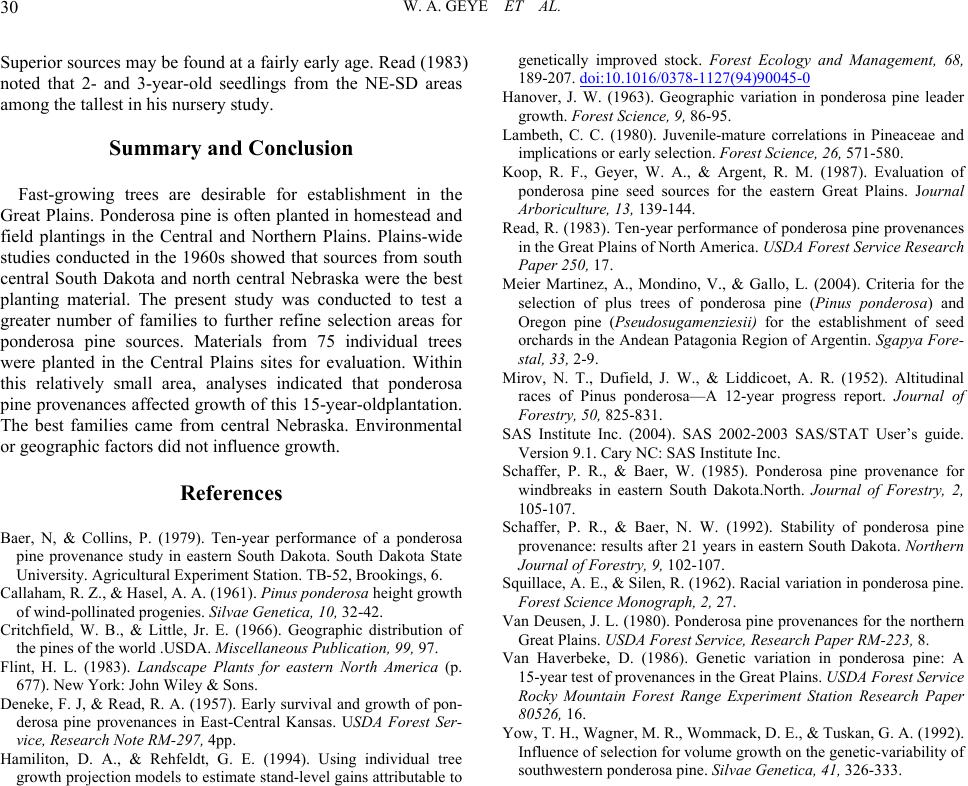
W. A. GEYE ET AL.
30
Superior sources may be found at a fairly early age. Read (1983)
noted that 2- and 3-year-old seedlings from the NE-SD areas
among the tallest in his nursery study.
Summary and Conclusion
Fast-growing trees are desirable for establishment in the
Great Plains. Ponderosa pine is often planted in homestead and
field plantings in the Central and Northern Plains. Plains-wide
studies conducted in the 1960s showed that sources from south
central South Dakota and north central Nebraska were the best
planting material. The present study was conducted to test a
greater number of families to further refine selection areas for
ponderosa pine sources. Materials from 75 individual trees
were planted in the Central Plains sites for evaluation. Within
this relatively small area, analyses indicated that ponderosa
pine provenances affected growth of this 15-year-oldplantation.
The best families came from central Nebraska. Environmental
or geographic factors did not influence growth.
References
Baer, N, & Collins, P. (1979). Ten-year performance of a ponderosa
pine provenance study in eastern South Dakota. South Dakota State
University. Agricultural Experiment Station. TB- 52, Brookings, 6.
Callaham, R. Z., & Hasel, A. A. (1961). Pinus ponderosa height growt h
of wind-pollinated progenies. Silvae Ge net ica , 10, 32-42.
Critchfield, W. B., & Little, Jr. E. (1966). Geographic distribution of
the pines of the world .USDA. Miscellaneous Publication, 99, 97.
Flint, H. L. (1983). Landscape Plants for eastern North America (p.
677). New York: John Wi ley & Sons.
Deneke, F. J, & Read, R. A. (1957). Early survival and growth of pon-
derosa pine provenances in East-Central Kansas. USDA Forest Ser-
vice, Research Note RM-297, 4pp.
Hamiliton, D. A., & Rehfeldt, G. E. (1994). Using individual tree
growth projection models to estimate stand-level gains attributable to
genetically improved stock. Forest Ecology and Management, 68,
189-207. doi:10.1016/0378-1127(94)90045-0
Hanover, J. W. (1963). Geographic variation in ponderosa pine leader
growth. Forest Science, 9, 86-95.
Lambeth, C. C. (1980). Juvenile-mature correlations in Pineaceae and
implications or early selection. Forest Science, 26, 571-580.
Koop, R. F., Geyer, W. A., & Argent, R. M. (1987). Evaluation of
ponderosa pine seed sources for the eastern Great Plains. Journal
Arboriculture, 13, 139-144.
Read, R. (1983). Ten-year performance of ponderosa pine provenances
in the Great Plains of North America. USDA Forest Service Research
Paper 250, 17.
Meier Martinez, A., Mondino, V., & Gallo, L. (2004). Criteria for the
selection of plus trees of ponderosa pine (Pinus ponderosa) and
Oregon pine (Pseudosugamenziesii) for the establishment of seed
orchards in the Andean Patagonia Region of Argentin. Sgapya Fore-
stal, 33, 2-9.
Mirov, N. T., Dufield, J. W., & Liddicoet, A. R. (1952). Altitudinal
races of Pinus ponderosa—A 12-year progress report. Journal of
Forestry, 50, 825-831.
SAS Institute Inc. (2004). SAS 2002-2003 SAS/STAT User’s guide.
Version 9.1. Cary NC: SAS Institute Inc.
Schaffer, P. R., & Baer, W. (1985). Ponderosa pine provenance for
windbreaks in eastern South Dakota.North. Journal of Forestry, 2,
105-107.
Schaffer, P. R., & Baer, N. W. (1992). Stability of ponderosa pine
provenance: results after 21 years in eastern South Dakota. Northern
Journal of Forestry, 9, 102-107.
Squillace, A. E., & Silen, R. (1962). Racial variation in ponderosa pine.
Forest Science Monograph, 2, 27.
Van Deusen, J. L. (1980). Ponderosa pine provenances for the northern
Great Plains. USDA Forest Service, Research Paper RM-223, 8.
Van Haverbeke, D. (1986). Genetic variation in ponderosa pine: A
15-year test of provenances in the Great Plains. USDA Forest Service
Rocky Mountain Forest Range Experiment Station Research Paper
80526, 16.
Yow, T. H., Wagner, M. R., Wommack, D. E., & Tuskan, G. A. (1992).
Influence of selection for volume growth on the genetic-variability of
southwestern ponderosa pine. Silvae Genetica, 41, 326-333.